“Does anyone make better soup than the Portuguese? I doubt it. Certainly no one makes better bread. And no one, I suspect, knows more ways to prepare salt cod.”
– Jean Anderson, The Food of Portugal
Buenos Aires – I’m going to claim a complete lack of creativity… more or less. I don’t know a lot about Portuguese food – I’ve tried some things here and there – and I’ve always loved having someone point out the subtle differences from Spanish cuisine. And there are differences, no question. But I handed myself over to the one expert I’ve encountered in my life, whom I had indirect access to. Roughly two decades ago I was invited to an event at the Portuguese Trade Commission in New York by Pasquale Iocca, the commission’s wine expert. Part of the event, as I recall, or maybe it happened tangentially, was the introduction of the book I quoted above, which can probably lay claim to being the English language bible of Portuguese cooking. I may have even been introduced to the author, I simply don’t recall. For our Portuguese seafood dinner, celebrating Republic Day there, I simply delved into the book and did my best to recreate the recipes and flavors that the author described. I hope I did them justice.
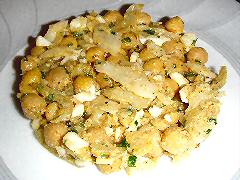 There was no question that at least one dish had to feature salt cod, or bacalhau as it’s known in Portuguese. It is a mainstay of the cuisine. Here, it’s damned expensive stuff, coming in at well over 100 pesos a kilo… but truly, it’s worth the investment to use real, properly cured and preserved salt cod, still just barely yielding to the touch – not the rock hard stuff that’s been sitting around on a shelf since god knows when. The dish, a simple salad, Salada de Bacalhau e Grão-de-bico, or Salad of Salt Cod and Chickpeas. The only “difficult” part of this dish is preparing the salt cod, which requires soaking in cold water in the refrigerator for 24 hours, changing the water every few hours, and then putting the cod into a pot with water, bringing it just to the edge of simmering and leaving it over the lowest heat for 15 minutes to poach through, and then left to cool in the same water – it turns out so flaky and tender you’ll never consider approaching it another way. The cod is then flaked – taking care to get the bones out – and added to a large bowl with cooked and cooled chickpeas (yes, canned, drained, and rinsed are acceptable), a few chopped hard boiled eggs (which I simply tossed in with the cod so they cooked and cooled along with it), thinly sliced onion, plenty of chopped garlic and parsley, sweet paprika, a bit of cayenne pepper, salt, black pepper, good olive oil (I used arbequina), and a bit of cider vinegar.
There was no question that at least one dish had to feature salt cod, or bacalhau as it’s known in Portuguese. It is a mainstay of the cuisine. Here, it’s damned expensive stuff, coming in at well over 100 pesos a kilo… but truly, it’s worth the investment to use real, properly cured and preserved salt cod, still just barely yielding to the touch – not the rock hard stuff that’s been sitting around on a shelf since god knows when. The dish, a simple salad, Salada de Bacalhau e Grão-de-bico, or Salad of Salt Cod and Chickpeas. The only “difficult” part of this dish is preparing the salt cod, which requires soaking in cold water in the refrigerator for 24 hours, changing the water every few hours, and then putting the cod into a pot with water, bringing it just to the edge of simmering and leaving it over the lowest heat for 15 minutes to poach through, and then left to cool in the same water – it turns out so flaky and tender you’ll never consider approaching it another way. The cod is then flaked – taking care to get the bones out – and added to a large bowl with cooked and cooled chickpeas (yes, canned, drained, and rinsed are acceptable), a few chopped hard boiled eggs (which I simply tossed in with the cod so they cooked and cooled along with it), thinly sliced onion, plenty of chopped garlic and parsley, sweet paprika, a bit of cayenne pepper, salt, black pepper, good olive oil (I used arbequina), and a bit of cider vinegar.
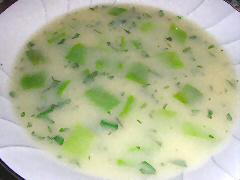 As I mentioned a week or so ago, we have beautiful green beans in the market – in particular the wide, flat kind, called chauchas here. When I spotted a recipe for a green bean and mint soup, I had to go with it – even though my guess would be that the original recipe called more for the “regular” green beans. The base of the soup was a couple of onions and garlic cloves, coarsely chopped and sauteed in olive oil until translucent and soft. Then I added a couple of peeled and diced potatoes, and topped it all off with chicken stock. Brought to a boil and then simmered until the vegetables were all cooked through and falling apart, about an hour. Skimmed the stuff that had risen to the top off, and then pureed it all to a silky broth using the hand blender – season with salt and white pepper to taste. Separately, I had cut the beans into ½” segments and then blanched them in salt water, shocking them in ice water to set the color and stop the cooking. When it was time to serve, I just added the beans to the hot broth, along with a large handful of freshly chopped mint – wait to chop it until the last minute or it has a tendency to turn black.
As I mentioned a week or so ago, we have beautiful green beans in the market – in particular the wide, flat kind, called chauchas here. When I spotted a recipe for a green bean and mint soup, I had to go with it – even though my guess would be that the original recipe called more for the “regular” green beans. The base of the soup was a couple of onions and garlic cloves, coarsely chopped and sauteed in olive oil until translucent and soft. Then I added a couple of peeled and diced potatoes, and topped it all off with chicken stock. Brought to a boil and then simmered until the vegetables were all cooked through and falling apart, about an hour. Skimmed the stuff that had risen to the top off, and then pureed it all to a silky broth using the hand blender – season with salt and white pepper to taste. Separately, I had cut the beans into ½” segments and then blanched them in salt water, shocking them in ice water to set the color and stop the cooking. When it was time to serve, I just added the beans to the hot broth, along with a large handful of freshly chopped mint – wait to chop it until the last minute or it has a tendency to turn black.
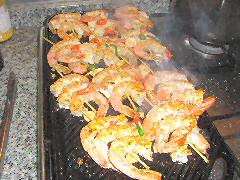
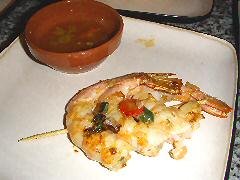
Are these beautiful shrimp, or what? This dish I took through different forms on the three nights. On all three versions, I marinated the shrimp in olive oil with thinly sliced garlic cloves and hot peppers – the only difference, the last night I let them marinate for a full 24 hours, rather than the 8 or so that they were in the marinade the first two days – it does make a difference in the flavors. The first night, I sauteed the shrimp until lightly browned – the problem was, they gave up way too much water, and shrank into mere wisps of their original selves – even half a dozen of them on a plate seemed a sorry offering. Still, they were flavorful, and they’re served up with a dipping sauce made from cider vinegar, olive oil, salt, and lots of chopped hot peppers – the traditional piri-piri peppers aren’t available here, but I found some small fiery peppers in one of the Bolivian markets that did the trick. The second and third nights I skewered the shrimp after marinating and then grilled them on the stovetop grill along with the chilies and garlic. What a wonderful smell as they browned, and they stayed nice and plump and got a beautiful golden color on them.
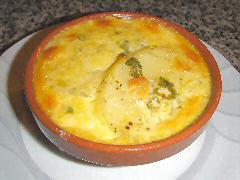 I thought about preparing a second salt cod dish for the main course – but expense negated the possibility. Probably the second most popular fish in Portugal, at least based on what I’ve read, is what they call pescada, here we call merluza, or in English, hake. For this dish, I boiled up some large potatoes until just cooked, then cooled, peeled, and sliced them. In little cazuela dishes, I put a splash of olive oil, then a piece of hake, which I topped with a splash of lemon juice, salt, pepper, and some chopped garlic that had been cooked slowly in butter for about 20 minutes until it was soft and mellow. Then a layer of potato slices topped with chopped parsley. Then repeat the two layers. The third night I used lime juice rather than lemon, just as an experiment – I think I like the lemon better. About an hour before serving time, I put into a pot (this is for a dozen or so portions) 8 tablespoons of butter, 10 tablespoons of flour, ½ teaspoon of cayenne, ½ teaspoon nutmeg, 1 teaspoon of sweet paprika, and then cooked those all together over medium heat for about five minutes to create a sort of basic roux. Then I added in 2 cups of cream and 4 cups of milk, and heated until near to a boil but not quite – stirring regularly, the mixture thickens and gets glossy. Taste to make sure it doesn’t taste “floury”. It should be thick enough to “coat a spoon” without running off back into the pot. At that point, 2 teaspoons of salt, the juice of a lemon, and two egg yolks got themselves all whisked into the mixture – off the heat. Then ladle that mixture into the cazuelas – roughly a half cup into each. Put in a hot oven and bake for 45 minutes until bubbling and lightly browned – if you want them slightly more browned, which I think looks pretty, just stick them under the broiler at the last moment for a minute or so. Serve with spoons – nobody wants to miss all that wonderful creamy sauce.
I thought about preparing a second salt cod dish for the main course – but expense negated the possibility. Probably the second most popular fish in Portugal, at least based on what I’ve read, is what they call pescada, here we call merluza, or in English, hake. For this dish, I boiled up some large potatoes until just cooked, then cooled, peeled, and sliced them. In little cazuela dishes, I put a splash of olive oil, then a piece of hake, which I topped with a splash of lemon juice, salt, pepper, and some chopped garlic that had been cooked slowly in butter for about 20 minutes until it was soft and mellow. Then a layer of potato slices topped with chopped parsley. Then repeat the two layers. The third night I used lime juice rather than lemon, just as an experiment – I think I like the lemon better. About an hour before serving time, I put into a pot (this is for a dozen or so portions) 8 tablespoons of butter, 10 tablespoons of flour, ½ teaspoon of cayenne, ½ teaspoon nutmeg, 1 teaspoon of sweet paprika, and then cooked those all together over medium heat for about five minutes to create a sort of basic roux. Then I added in 2 cups of cream and 4 cups of milk, and heated until near to a boil but not quite – stirring regularly, the mixture thickens and gets glossy. Taste to make sure it doesn’t taste “floury”. It should be thick enough to “coat a spoon” without running off back into the pot. At that point, 2 teaspoons of salt, the juice of a lemon, and two egg yolks got themselves all whisked into the mixture – off the heat. Then ladle that mixture into the cazuelas – roughly a half cup into each. Put in a hot oven and bake for 45 minutes until bubbling and lightly browned – if you want them slightly more browned, which I think looks pretty, just stick them under the broiler at the last moment for a minute or so. Serve with spoons – nobody wants to miss all that wonderful creamy sauce.
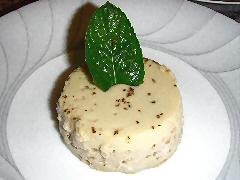 Finally, I wanted to do something a little different, and settled on a traditional tea pudding. Yup, tea pudding. Very simple – into a mixer I put a cup of sugar and a large spoonful of black tea leaves. Then I poured two cups of boiling water into the bowl, ran the mixer on high for just a couple of seconds, and put a lid on it so that it could stay hot and steep for about 10 minutes. At that point, I poured in a cup of heavy cream, 6 egg yolks, and 6 whole eggs and ran the mixer on high until it was well blended, about 15-20 seconds. Strained through a coarse strainer to leave little flecks of tea leaves in the mixture – if you prefer not, use a fine strainer. Then into buttered ramekins which I put in a baking pan with hot water poured around them, and baked for 45 minutes until they were nice and firm and just slightly pulling away from the sides. Cool, then chill, and then unmold into bowls (a quick dip in hot water and a palate knife run around the inside edge and they flip right out. I considered whipped cream, but the author insisted that this is not traditional at all and would simply never be done – so a garnish of some mint leaves and served it up.
Finally, I wanted to do something a little different, and settled on a traditional tea pudding. Yup, tea pudding. Very simple – into a mixer I put a cup of sugar and a large spoonful of black tea leaves. Then I poured two cups of boiling water into the bowl, ran the mixer on high for just a couple of seconds, and put a lid on it so that it could stay hot and steep for about 10 minutes. At that point, I poured in a cup of heavy cream, 6 egg yolks, and 6 whole eggs and ran the mixer on high until it was well blended, about 15-20 seconds. Strained through a coarse strainer to leave little flecks of tea leaves in the mixture – if you prefer not, use a fine strainer. Then into buttered ramekins which I put in a baking pan with hot water poured around them, and baked for 45 minutes until they were nice and firm and just slightly pulling away from the sides. Cool, then chill, and then unmold into bowls (a quick dip in hot water and a palate knife run around the inside edge and they flip right out. I considered whipped cream, but the author insisted that this is not traditional at all and would simply never be done – so a garnish of some mint leaves and served it up.
All in all, I think the evening turned out quite well, and people were loving the food. Something to be said, now and again, for sticking to tried and true recipes…
What I wouldn’t give to go to a restaurant here and have the food at least look as beautiful as the food does on your blog!!!! We did find ONE restaurant here – Saga in Escazú – that served elegant food elegantly presented that tasted heavenly. I oohed and aahed over every bite. That was a real treat! Love seeing your pictures!
Awww, thanks. You know, like the Prophet Elijah, we’re saving a seat for you for when you finally come to visit!
I’m off to Lisbon next week, so I’ll let you know how close you came to hitting the mark. Of course, I’d be happy to eat any meal you prepared.
[…] at https://www.saltshaker.net/20071010/sailing-the-high-seas delivered by […]
[…] beautiful green beans in the market I couldn’t resist another stab at the Portuguese style green bean and mint soup from pretty much exactly a year […]
What I wouldn’t give to go to a restaurant here and have the food at least look as beautiful as the food does on your blog!!!! We did find ONE restaurant here – Saga in Escazú – that served elegant food elegantly presented that tasted heavenly. I oohed and aahed over every bite. That was a real treat! Love seeing your pictures!
[…] back one of our favorite soups from Portugal, green bean and mint, just putting in a corn and carrot stock in place of the chicken […]